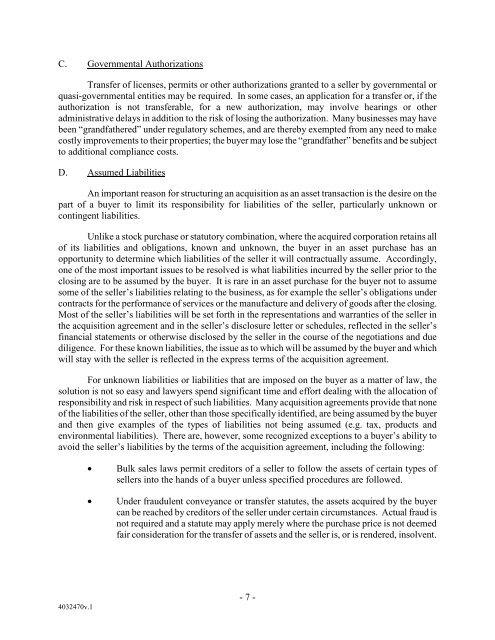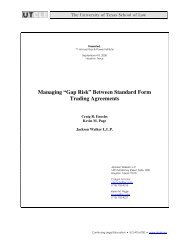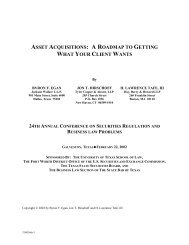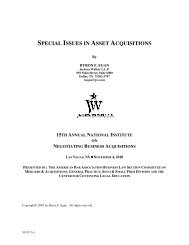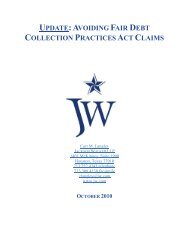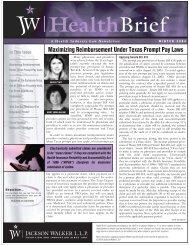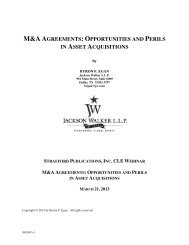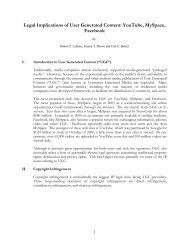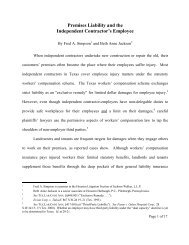busted m&a deals headed for litigation - Jackson Walker LLP
busted m&a deals headed for litigation - Jackson Walker LLP
busted m&a deals headed for litigation - Jackson Walker LLP
Create successful ePaper yourself
Turn your PDF publications into a flip-book with our unique Google optimized e-Paper software.
C. Governmental Authorizations<br />
Transfer of licenses, permits or other authorizations granted to a seller by governmental or<br />
quasi-governmental entities may be required. In some cases, an application <strong>for</strong> a transfer or, if the<br />
authorization is not transferable, <strong>for</strong> a new authorization, may involve hearings or other<br />
administrative delays in addition to the risk of losing the authorization. Many businesses may have<br />
been “grandfathered” under regulatory schemes, and are thereby exempted from any need to make<br />
costly improvements to their properties; the buyer may lose the “grandfather” benefits and be subject<br />
to additional compliance costs.<br />
D. Assumed Liabilities<br />
An important reason <strong>for</strong> structuring an acquisition as an asset transaction is the desire on the<br />
part of a buyer to limit its responsibility <strong>for</strong> liabilities of the seller, particularly unknown or<br />
contingent liabilities.<br />
Unlike a stock purchase or statutory combination, where the acquired corporation retains all<br />
of its liabilities and obligations, known and unknown, the buyer in an asset purchase has an<br />
opportunity to determine which liabilities of the seller it will contractually assume. Accordingly,<br />
one of the most important issues to be resolved is what liabilities incurred by the seller prior to the<br />
closing are to be assumed by the buyer. It is rare in an asset purchase <strong>for</strong> the buyer not to assume<br />
some of the seller’s liabilities relating to the business, as <strong>for</strong> example the seller’s obligations under<br />
contracts <strong>for</strong> the per<strong>for</strong>mance of services or the manufacture and delivery of goods after the closing.<br />
Most of the seller’s liabilities will be set <strong>for</strong>th in the representations and warranties of the seller in<br />
the acquisition agreement and in the seller’s disclosure letter or schedules, reflected in the seller’s<br />
financial statements or otherwise disclosed by the seller in the course of the negotiations and due<br />
diligence. For these known liabilities, the issue as to which will be assumed by the buyer and which<br />
will stay with the seller is reflected in the express terms of the acquisition agreement.<br />
For unknown liabilities or liabilities that are imposed on the buyer as a matter of law, the<br />
solution is not so easy and lawyers spend significant time and ef<strong>for</strong>t dealing with the allocation of<br />
responsibility and risk in respect of such liabilities. Many acquisition agreements provide that none<br />
of the liabilities of the seller, other than those specifically identified, are being assumed by the buyer<br />
and then give examples of the types of liabilities not being assumed (e.g. tax, products and<br />
environmental liabilities). There are, however, some recognized exceptions to a buyer’s ability to<br />
avoid the seller’s liabilities by the terms of the acquisition agreement, including the following:<br />
• Bulk sales laws permit creditors of a seller to follow the assets of certain types of<br />
sellers into the hands of a buyer unless specified procedures are followed.<br />
• Under fraudulent conveyance or transfer statutes, the assets acquired by the buyer<br />
can be reached by creditors of the seller under certain circumstances. Actual fraud is<br />
not required and a statute may apply merely where the purchase price is not deemed<br />
fair consideration <strong>for</strong> the transfer of assets and the seller is, or is rendered, insolvent.<br />
4032470v.1<br />
- 7 -


